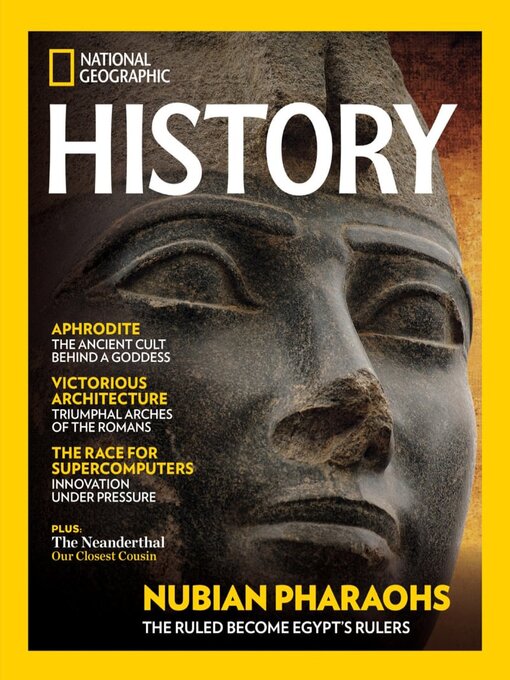See how National Geographic History magazine inflames and quenches the curiosity of history buffs and informs and entertains anyone who appreciates that the truth indeed is stranger than fiction with a digital subscription today. And that history is not just about our forebears. It’s about us. It’s about you.
FROM THE EDITOR
National Geographic History
Colorful Signs of a Lost Culture of Hunter-Artists • Art adorning rock-shelters in a remote zone of Venezuela was created millennia ago by artists whose designs spread across the region.
GOING THE DISTANCE
THE WORK OF ANCIENT HANDS
Jean-Henri Dunant: Peacemaker and Activist • A Swiss businessman co-founded the Red Cross after witnessing the carnage of a battlefield. Warning of worse wars to come, he cajoled countries to join the First Geneva Convention.
The Lifelong Battle for Peace
PROPHETIC WORDS
ARMBAND AGAINST ARMS
The First Missions of the Red Cross • From 1864, the International Committee of the Red Cross sent orderlies to battlefields across Europe. The movement inspired Red Crescent associations in Muslim-majority countries. The Red Cross was established in Japan in the 1870s.
Pajamas: From Street Wear to Sleepwear • The British adopted the loose pants they saw men in India wearing as outerwear. Rapidly changing social trends made pjs acceptable as unisex sleepwear, and cinema turned them into fashion essentials.
CAP AND GOWN
Lost Gold-Leaf Paintings Proclaim a Glittering Past • Hidden for centuries in a Spanish church, the rediscovered frescoes of Llerena speak of a small town’s 16th-century heyday.
THE TWILIGHT OF THE NEANDERTHALS THE EXTINCTION OF A HUMAN SPECIES • The Neanderthals’ extinction has been attributed to the arrival of our species, Homo sapiens. But their decline cannot be traced to a single cause. Changes in the climate and the structure of their society may have been decisive.
A GRADUAL DECLINE
A SYMBOLIC CULTURE OF THEIR OWN
SIMILARITIES AND DIFFERENCES
TRACING DENNY’S NEANDERTHAL ROOTS
PART OF THE SIXTH EXTINCTION?
TRACES OF A TRANSITION
CARING AND SHARING IN SMALL COMMUNITIES
NUBIA AND EGYPT THE NUBIAN PHARAOHS • Once vassals to Egyptian pharaohs, the Kushite kings of Nubia took control of Egypt circa 750 b.c. and ruled for almost a century. Embracing Egyptian rituals, they created a syncretic culture that influenced both civilizations.
A TALE OF TWO POWERS: NUBIA AND EGYPT
The Shabaka Stone
In Honor of Amun
Miraculous Deeds
NUBIA’S SACRED MOUNTAIN
APHRODITE GODDESS OF DESIRE • A mix of ancient fertility goddesses and eastern divinities, Aphrodite was particularly venerated by the Greeks. From the main sanctuary in Cyprus, her cult spread around the Mediterranean.
APHRODITE, ALWAYS ADORED
Cyprus, Land of Fertility Figurines
APHRODITE, THE GODDESS WHO LATER REVEALED ALL • In the Greek art of the sixth and fifth centuries b.c., Aphrodite was depicted as a fully clothed, majestic goddess. From the fourth century b.c., she started to appear as the now iconic image of a voluptuous naked woman.
APHRODITE IN APHRODISIAS
VENUS PATRONESS OF POMPEII • Venus-Aphrodite became the most venerated deity in the Roman city of Pompeii. Archaeologists have found murals featuring Venus in many of the houses that have been excavated.
TRIUMPHAL ARCHES ROME COMMEMORATES ITS VICTORIES • Once temporary backdrops for celebrations, these monuments evolved into enduring icons of Rome’s power.
ART FOR A PEOPLE AT ARMS
ANATOMY OF THE ARTWORKS
The First Supercomputers • In the 1940s and ‘50s, programmable machines capable of performing calculations and operations on a scale never...

 March/April 2025
March/April 2025
 January/February 2025
January/February 2025
 November/December 2024
November/December 2024
 September/October 2024
September/October 2024
 July/August 2024
July/August 2024
 May/June 2024
May/June 2024
 March/April 2024
March/April 2024
 January/February 2024
January/February 2024
 November/December 2023
November/December 2023
 September/October 2023
September/October 2023
 July/August 2023
July/August 2023
 May/June 2023
May/June 2023
 March/April 2023
March/April 2023
 January/February 2023
January/February 2023
 November/December 2022
November/December 2022
 September/October 2022
September/October 2022
 July/August 2022
July/August 2022
 May/June 2022
May/June 2022
 March/April 2022
March/April 2022
 January/February 2022
January/February 2022
 November/December 2021
November/December 2021
 September/October 2021
September/October 2021
 July/August 2021
July/August 2021
 May/June 2021
May/June 2021